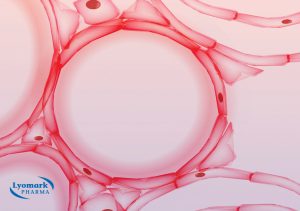
The importance of a healthy and a well-functioning immune system is especially apparent in times of a worldwide pandemic. Pathogenic microorganisms often find their way into our bodies through the lungs, which requires an initial, appropriately developed immune response. Since neutrophil granulocytes are the first immune cells to reach the site of infection, they play an important role in defending the lung against invading pathogens. One particular defense mechanism performed by these cells is the formation of neutrophil extracellular traps (NETs), which lead to a confinement of the infectious agents.
It is known that pulmonary surfactant has immunoregulatory and anti-inflammatory properties, which are mainly exerted by the surfactant proteins SP-A and SP-D.
The hydrophobic surfactant proteins, SP-B and SP-C, play a critical role in reducing surface tension. Commercial surfactant preparations lack SP-A and SP-D due to manufacturing processes. However, recent studies have shown that both phospholipids and the hydrophobic proteins SP-B and SP-C also have equally anti-inflammatory and antibacterial effects. This effect was demonstrated and thus confirmed in a study at the University Medical Center Hamburg-Eppendorf by pediatrician and clinical scientist Dr. Julian Trah and his research group: The immunoregulatory effects on NET formation in neutrophil granulocytes of two common clinically used surfactants (Alveofact®, Curosurf®) were investigated.
Both surfactant preparations were shown to exert a time- and dose-dependent inhibitory effect on NET formation, with a stronger inhibitory effect of Alveofact® on Netosis.
The author suspects that this may be due to the different composition. Curosurf® is made from minced pig lungs, while Alveofact® is derived from bovine lung lavage, which is less contaminated with plasmic and tissue debris due to the manufacturing process. Another possible explanation for the discrepant results could be the larger fraction of SP-B and SP-C in Alveofact®, as previously documented in a comparative study, suggested Dr. Trah.
However, the results of this study are of great importance, as the described dose-dependent influence on NET formation ex vivo suggests an interaction between exogenous surfactant addition and neutrophil granulocytes. Since some inflammatory chronic lung diseases are associated with the development of NETs, this study provides new perspectives on how pulmonary surfactant could be a potential candidate to attenuate inflammation. Net formation could represent a target point for new potential drugs, but this obviously requires further investigation. Nevertheless, Alveofact® could possibly represent a preventive treatment option against NET formation in the future.
Further information on the study can be found here.
Dr. Dr. Romina Weinhold
Head of Medical Affairs
Lyomark Pharma GmbH
